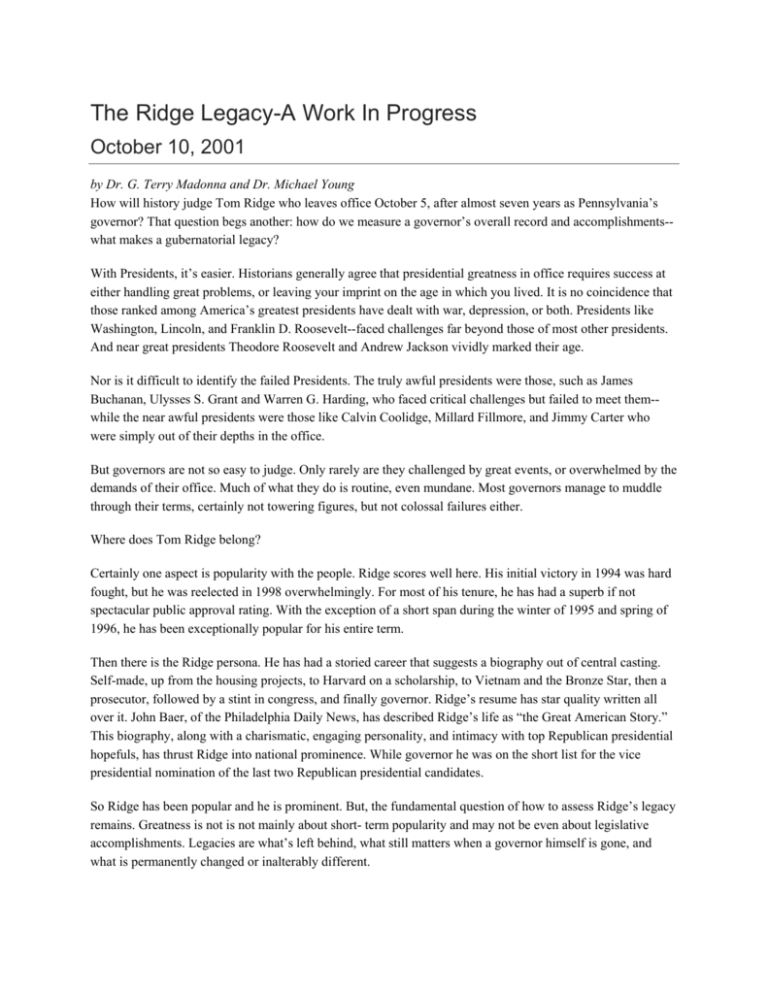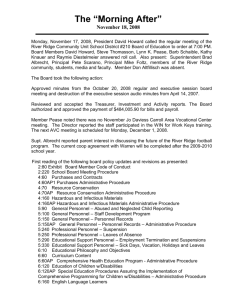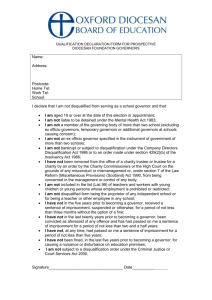The Ridge Legacy-A Work In Progress
advertisement

The Ridge Legacy-A Work In Progress October 10, 2001 by Dr. G. Terry Madonna and Dr. Michael Young How will history judge Tom Ridge who leaves office October 5, after almost seven years as Pennsylvania’s governor? That question begs another: how do we measure a governor’s overall record and accomplishments-what makes a gubernatorial legacy? With Presidents, it’s easier. Historians generally agree that presidential greatness in office requires success at either handling great problems, or leaving your imprint on the age in which you lived. It is no coincidence that those ranked among America’s greatest presidents have dealt with war, depression, or both. Presidents like Washington, Lincoln, and Franklin D. Roosevelt--faced challenges far beyond those of most other presidents. And near great presidents Theodore Roosevelt and Andrew Jackson vividly marked their age. Nor is it difficult to identify the failed Presidents. The truly awful presidents were those, such as James Buchanan, Ulysses S. Grant and Warren G. Harding, who faced critical challenges but failed to meet them-while the near awful presidents were those like Calvin Coolidge, Millard Fillmore, and Jimmy Carter who were simply out of their depths in the office. But governors are not so easy to judge. Only rarely are they challenged by great events, or overwhelmed by the demands of their office. Much of what they do is routine, even mundane. Most governors manage to muddle through their terms, certainly not towering figures, but not colossal failures either. Where does Tom Ridge belong? Certainly one aspect is popularity with the people. Ridge scores well here. His initial victory in 1994 was hard fought, but he was reelected in 1998 overwhelmingly. For most of his tenure, he has had a superb if not spectacular public approval rating. With the exception of a short span during the winter of 1995 and spring of 1996, he has been exceptionally popular for his entire term. Then there is the Ridge persona. He has had a storied career that suggests a biography out of central casting. Self-made, up from the housing projects, to Harvard on a scholarship, to Vietnam and the Bronze Star, then a prosecutor, followed by a stint in congress, and finally governor. Ridge’s resume has star quality written all over it. John Baer, of the Philadelphia Daily News, has described Ridge’s life as “the Great American Story.” This biography, along with a charismatic, engaging personality, and intimacy with top Republican presidential hopefuls, has thrust Ridge into national prominence. While governor he was on the short list for the vice presidential nomination of the last two Republican presidential candidates. So Ridge has been popular and he is prominent. But, the fundamental question of how to assess Ridge’s legacy remains. Greatness is not is not mainly about short- term popularity and may not be even about legislative accomplishments. Legacies are what’s left behind, what still matters when a governor himself is gone, and what is permanently changed or inalterably different. Good timing plays a role here. Governors like presidents are evaluated in terms of the times they live through, and Tom Ridge’s times have been exceptionally good ones Throughout seven years as governor, he has been truly blessed with a set of fortuitous circumstances unmatched by any other Pennsylvania governor in modern times. His time in office paralleled the spectacular growth of the national economy, and he leaves office just as economists have officially called the current economy a recession. Nor has he faced a calamity that threatened the safety and security of Pennsylvania’s citizens. Not all recent governors have been so lucky. For example, when Republican Gifford Pinchot took the oath of office as governor in 1931, he inherited the wrath of the Great Depression. Despite calling three special sessions of the legislature, relief and recovery measures went unapproved. Pinchot spent his entire four years crusading for anti-depression legislation. Pinchot’s successor, Democrat George Earle, faced similar challenges. His Little New Deal proposals found some success but he spent his tenure wrestling with some of the most significant reform measures in Pennsylvania history--old age pensions, compulsory unemployment insurance, minimum wage and maximum hour laws, and the prohibition of child labor. Since these governors of the Great Depression era, almost every Pennsylvania governor has faced to some degree the dual ravages of high unemployment, and consequent deficit state budgets. In the late 1960s, for example, progressive Republican Governor Ray Shafer facing economic sluggishness asked the legislature for 270 million in new taxes. Ultimately, his support for a new income tax caused him to be drummed out of his own party. More recently, the governorship of Dick Thornburgh offers more insights into challenges and hard times faced by recent governors. Ten weeks into his first term, the new governor faced the partial meltdown of the reactor core at the Three Mile Island nuclear power plant. A calm, cool Thornburgh handled the crisis with aplomb, earning him national praise. More typical, however, was Thornburgh’s fiscal problems that included a deficit from his predecessor Milton Shapp and a recession on the eve of his re-election effort in 1982, an election he narrowly won. By comparison with many of his predecessors Tom Ridge has shared a different fate. No other governor in recent times has had the advantage of his own party controlling both chambers of the state legislature for his entire time in office. Republican legislative leaders until recently have enthusiastically pressed the Ridge agenda into law with a frequency unparalleled in the twentieth century. Without the necessity of negotiating with Democratic legislative leaders, Ridge’s agenda has been the focal point of legislative business since 1995. Fiscally things have gone smoothly for him, also. He inherited a 250 million dollar surplus from Bob Casey and has had hundreds of millions in surpluses throughout his seven years. In short, Tom Ridge has not had to lay off workers, cut programs because of budget deficits, or raise taxes. He has spent his entire seven years implementing his 1994 election campaign agenda, along with some modest new programs that surpluses have permitted. His success rate has been impressive by any comparison, with virtually all of his promises delivered upon. In crime legislation, welfare reform, education policy, regulatory reform and fiscal management, the Ridge record is impressive. By reversing Pennsylvania’s reputation as a state hostile to business, he has once again made the state competitive for new businesses. Only school vouchers and the sale of the state’s liquor stores remain undelivered, and no political consensus had been reached on these issues anyway. In the end, Ridge has more clearly understood the complex economic changes at work than almost any other state leader. He has worked hard to move the state’s economy forward into e-commerce and technology, paving the way for a new economic foundation. So, Ridge has been successful--in fact, very successful, but also fortunate. During his tenure, his party has dominated the legislature, the economy has been great, and the problems few. Some believe these advantages vitiate his accomplishments. His critics argue that any governor would have done as well, given the same wind at his or her back. But this sort of thinking is specious, and petty, too. Governors have to be understood and legacies assessed in terms of what they accomplish or leave unaccomplished. Being governor is not something we can handicap as one would a horse race or a golf tournament. Just because Ridge had a set of fortuitous circumstances does not diminish his accomplishments. Nor will Pennsylvanians be less enriched by the changes and improvements under Ridge, merely because he did not have to struggle as hard as some other governors. Tom Ridge has been a successful governor. We will leave it to future historians to debate how successful. Meanwhile, his future continues to unfold. Most retired Pennsylvania governors leave public life. Tom Ridge, however, is on his way to Washington to join the Bush cabinet, and tackle what may be the toughest job in America. His work in Pennsylvania is finished. But at age 56, his legacy may be still a work in progress. -----------------Politically Uncorrected™ is published twice monthly. Dr. G. Terry Madonna is a Professor of Public Affairs at Franklin & Marshall College, and Dr. Michael Young is a former Professor of Politics and Public Affairs at Penn State University and Managing Partner at Michael Young Strategic Research. The opinions expressed in this article are solely those of the authors and do not necessarily reflect the opinions of any institution or organization with which they are affiliated. This article may be used in whole or part only with appropriate attribution. Copyright © 2001 Terry Madonna and Michael Young.







